#Computer & Tech Components
Explore tagged Tumblr posts
Text

Computer Components Suppliers | Kahridiye | Computer & Tech Components
Kahridiye is a trusted computer components suppliers offering a wide range of high-quality products to meet all your computing needs. From processors, motherboards, and graphic cards to peripherals and accessories, Kahridiye ensures top-notch products at competitive prices.

2 notes
·
View notes
Text
Month 8, day 26
IT'S DONE!!! HALLELUJAH!!!!
I had a glitch with Bubble 11 that I had to fix but luckily the fix itself was simple, it was figuring out which set of frames around the glitch needed re-rendering that I struggled with XD
But it's done, I did it, yay! :D
Music is "The Day The World Revived" from Chrono Trigger :) There's also a lamp buzz and bubbling noise I got from Pixabay :)
#the great artscapade of 2024#art#my art#blender#blender render#eevee render#in related news I opted not to bid on the iMacs that were up for auction#because DESPITE MY $4+/HOUR RAISE I went negative on my bank account buying us groceries#but!#in theory!#I should be able to start saving up for an ACTUALLY new computer which will serve me much better than old/refurbished tech would#roommate recommends a MacBook Pro bc those tend to get the priority in updated top-of-the-line tech components#or so he tells me lol#but either way that would be great because I would ADORE a portable option#and I have been lusting after a MacBook Pro of my very own ever since they introduced the touch bar#which doesn't exist anymore and I'm Big Sads about it but whatever#I want a laptop#I want the versatility of doing my intensive blender bullshit at my desk and lounging in bed to write on the same machine#so that's my goal for my next computer :)#whenever that's financially feasible anyway lol
2 notes
·
View notes
Text
Is Intel's New CPU Better Than AMD's New CPU? Let's Break It Down
When it comes to choosing the best CPU for your needs, the rivalry between Intel and AMD is always a topic of debate. Both brands have released some incredible processors recently, but which one is truly better? Is Intel's new CPU really that much better than AMD's new CPU? Well, the answer isn't as clear-cut as you might think.
Intel's latest processors, like the Intel Core i7 and Intel Core i9 from their 13th generation, have brought significant performance improvements. They boast faster clock speeds, enhanced multi-core capabilities, and better single-threaded performance, making them a great choice for gaming and multitasking. But is that enough to outdo AMD’s latest offerings, like the AMD Ryzen 7000 series?
AMD’s processors are no slouches either. With impressive multi-threaded performance, better power efficiency, and a more affordable price tag, AMD has been dominating in certain segments, especially for users looking for solid performance on a budget.
So, which one is better? It really depends on what you're looking for. If you need maximum single-threaded performance for tasks like gaming or software that demands high clock speeds, Intel might be the better option. But, if you want a CPU that excels in multi-core tasks, provides great value, and runs cooler, AMD could be your winner.
At the end of the day, both brands offer high-performance CPUs that deliver excellent results. It’s important to understand your needs and choose the one that aligns with your computing requirements. Whether you choose Intel or AMD, rest assured that you're getting top-tier performance.
Visit Blumenit Computer for more information on the latest CPUs and expert guidance on making the right choice for your build.
#Intel CPU#AMD CPU#gaming performance#Ryzen 7000#Intel i7#Intel i9#AMD Ryzen#PC performance#gaming PC#CPU comparison#multi-core#single-threaded performance#PC upgrades#tech advice#best CPU for gaming#Intel vs AMD#CPU showdown#new CPU releases#tech solutions#Intel Core i7#Blumenit Computer#computer upgrades#desktop components#high-performance hardware#laptop solutions#computer advice#PC optimization#technology#PC building#powerful processors
0 notes
Text
TechFitz is a go-to Online Shop for all Your Computer Needs
TechFitz: Your one-stop online destination for top- quality computer, server, and laptop parts and peripherals in the Middle East. Experience unparalleled selection, expert advice, and exceptional service, all tailored to power your digital life.
#computer hardware and parts#buy electronic components online#buy tech components#laptop spare parts#buy laptop chassis online
1 note
·
View note
Text
Ultimate Cooling Showdown: 5 Top CPU Coolers for Ryzen 7 7800X3D
This blog is an Amazon affiliate, which means that if you click on a paid link from this website that takes you to Amazon and you purchase a product, I will receive a small commission. You can find links to Amazon in the highlighted words. AMD’s latest Ryzen 7000 series with 3D-V Cache promises a significant leap in performance, but keeping that power tamed requires a top-notch CPU cooler. This…

View On WordPress
#3D V-Cache#AIO liquid coolers#air coolers#AMD Ryzen 7000 series#budget CPU coolers#computer hardware#cooling solutions#CPU coolers#gaming PC#High-performance cooling#overclocking#PC components#pc cooling#performance cooling#RGB lighting#Ryzen 7 7800X3D#silent coolers#tech reviews
1 note
·
View note
Text
The HPE MSA P00442-001 is a high-capacity 12TB 12G SAS hard drive designed to meet the storage demands of modern data-intensive environments. With a focus on performance, reliability, and compatibility, this hard drive is an excellent addition to HPE MSA storage systems.
HPE P00442-001 OVERVIEW:
HPE MSA Midline Hard Drives are ideal for business critical workloads that require bulk data storage for digital content and cloud infrastructures. With a Maximum Storage Capacity of 12 Terabytes, the New HPE P00442-001 allows for far greater bulk storage compared to other HPE MSA Hard Drives.
HPE Enterprise MSA Hard Drives offer the highest level of performance and reliability for the most demanding applications workloads. HPE MSA Hard Drives improve response times, power far more transactions per second and accelerate data transfer (I/O) speeds. HPE MSA 12 Terabyte, 12G/Sec Transfer Rate, 3.5 inch Large Form Factor, 7.2k Spindle Speed, 512e Advanced Formatted, SAS MSA Hard Drive for HPE Modular Smart Arrays.
HPE P00442-001 SPECIFICATIONS:
Option Part Number: Q2R42A Spare Part Number: P00442-001 Model Number: HUH721212AL5204 Manufacturer: HPE Storage Capacity: 12 Terabyte Data Transfer Rate: 12G Spindle Speed: 7,200Rpm Features: 512e Advanced Formatted
HPE P00442-001 COMPATIBILITY:
The HPE P00442-001 is Compatible with the following HPE MSA2 SAN Storage Arrays:
HPE MSA2 1040 SAN Storage Array HPE MSA2 2040 SAN Storage Array HPE MSA2 2050 SAN Storage Array HPE MSA2 2052 SAN Storage Array HPE MSA 2000 G1 Storage Array HPE MSA 2000 G2 Storage Array HPE MSA2 P2000 G3 Storage Array HPE MSA2 P2000 G4 Storage Array
#Computer Parts#Server Parts#Tech Accessories#Computer Accessories#Hardware Components#Networking Devices#PC Components
0 notes
Text
What is Dataflow?
This post is inspired by another post about the Crowd Strike IT disaster and a bunch of people being interested in what I mean by Dataflow. Dataflow is my absolute jam and I'm happy to answer as many questions as you like on it. I even put referential pictures in like I'm writing an article, what fun!
I'll probably split this into multiple parts because it'll be a huge post otherwise but here we go!
A Brief History

Our world is dependent on the flow of data. It exists in almost every aspect of our lives and has done so arguably for hundreds if not thousands of years.
At the end of the day, the flow of data is the flow of knowledge and information. Normally most of us refer to data in the context of computing technology (our phones, PCs, tablets etc) but, if we want to get historical about it, the invention of writing and the invention of the Printing Press were great leaps forward in how we increased the flow of information.
Modern Day IT exists for one reason - To support the flow of data.
Whether it's buying something at a shop, sitting staring at an excel sheet at work, or watching Netflix - All of the technology you interact with is to support the flow of data.
Understanding and managing the flow of data is as important to getting us to where we are right now as when we first learned to control and manage water to provide irrigation for early farming and settlement.
Engineering Rigor
When the majority of us turn on the tap to have a drink or take a shower, we expect water to come out. We trust that the water is clean, and we trust that our homes can receive a steady supply of water.
Most of us trust our central heating (insert boiler joke here) and the plugs/sockets in our homes to provide gas and electricity. The reason we trust all of these flows is because there's been rigorous engineering standards built up over decades and centuries.

For example, Scottish Water will understand every component part that makes up their water pipelines. Those pipes, valves, fitting etc will comply with a national, or in some cases international, standard. These companies have diagrams that clearly map all of this out, mostly because they have to legally but also because it also vital for disaster recovery and other compliance issues.
Modern IT
And this is where modern day IT has problems. I'm not saying that modern day tech is a pile of shit. We all have great phones, our PCs can play good games, but it's one thing to craft well-designed products and another thing entirely to think about they all work together.
Because that is what's happened over the past few decades of IT. Organisations have piled on the latest plug-and-play technology (Software or Hardware) and they've built up complex legacy systems that no one really knows how they all work together. They've lost track of how data flows across their organisation which makes the work of cybersecurity, disaster recovery, compliance and general business transformation teams a nightmare.

Some of these systems are entirely dependent on other systems to operate. But that dependency isn't documented. The vast majority of digital transformation projects fail because they get halfway through and realise they hadn't factored in a system that they thought was nothing but was vital to the organisation running.
And this isn't just for-profit organisations, this is the health services, this is national infrastructure, it's everyone.
There's not yet a single standard that says "This is how organisations should control, manage and govern their flows of data."
Why is that relevant to the companies that were affected by Crowd Strike? Would it have stopped it?
Maybe, maybe not. But considering the global impact, it doesn't look like many organisations were prepared for the possibility of a huge chunk of their IT infrastructure going down.
Understanding dataflows help with the preparation for events like this, so organisations can move to mitigate them, and also the recovery side when they do happen. Organisations need to understand which systems are a priority to get back operational and which can be left.
The problem I'm seeing from a lot of organisations at the moment is that they don't know which systems to recover first, and are losing money and reputation while they fight to get things back online. A lot of them are just winging it.
Conclusion of Part 1
Next time I can totally go into diagramming if any of you are interested in that.
How can any organisation actually map their dataflow and what things need to be considered to do so. It'll come across like common sense, but that's why an actual standard is so desperately needed!
789 notes
·
View notes
Text
The Mandalorian: Din Djarin's Mandalorian Armor & Helmet
Well, since The Mandalorian TV series is going to be a wrap & we're not going to see anything new until The Mandalorian & Grogu film drops, there is one thing I've been wondering about when it comes to Din Djarin's Mandalorian Armor & Helmet….
After his 'Battle of the Mudhorn', Din Djarin & his Mandalorian Armor suffered substantial injury/damage. Even though Djarin did a pretty good job repairing himself, it was quite obvious the Armor took the brunt of all of the damage inflicted by the Mudhorn, and certain parts would have to be replaced. And I liked how they showed Din using his tools to fix his armor; it reminded me of how Tony Stark would use his tools to work on his Iron Man Armor.
But what really struck me were the electronics, circuitry, cabling, tubing & wiring that were exposed just beneath the Armor plating. It seems that Din Djarin's Mando Armor is layered: Outside is the Beskar, while underneath lies the high tech circuits & components. Similar to the hardware that you may see on a circuit board, or what may be seen if you opened up a TV, computer, cell phone or other electronic device.
Although I knew the Mandalorian Helmet was very sophisticated & advanced, I never thought the same of Mandalorian Armor being that complex with electronic components embedded in the armor. I'm curious as to what all of the apparatus & gadgetry are for & exactly what are their functions/ purposes. I also noticed the inner workings of circuitry in a layer of the Armor matches the circuitry located in the interior of Din's Mandalorian Helmet.
Hopefully, some sort of detailed diagram, chart, blueprint, schematic or something similar will be released, showing the layers and the interior build of both Din's Armor and his Helmet.



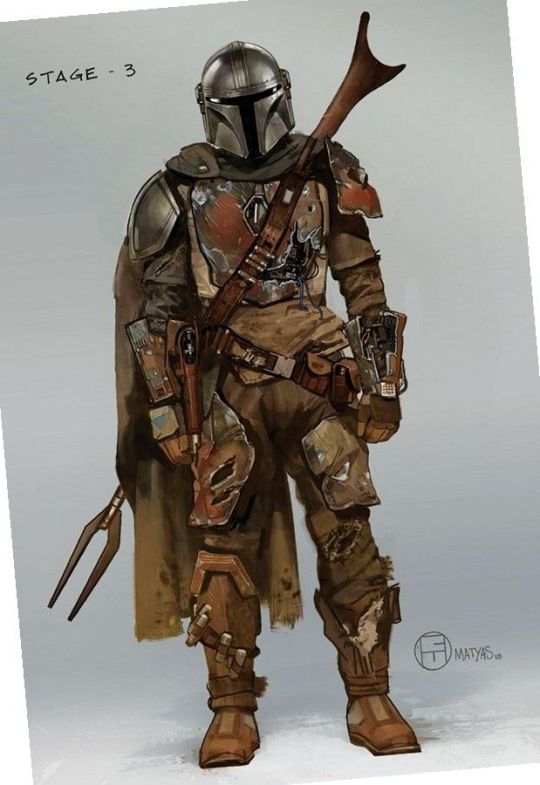












#the mandalorian#din djarin#mandalorian armor#mandalorian helmet#din djarin mandalorian helmet#din djarin mandalorian armor#din djarin mandalorian helmet interior#mandalorian helmet interior#mandalorian armor repair#mandalorian armor interior#beskar'gam#beskar#mandalorian armor technology#mandalorian helmet t-visor#mandalorian t-visor#mandalorian technology#mando tech#mandalorian helmet technology#mandalorian helmet tech#mandalorian armor tech#mandalorian forearm gauntlets#mandalorian forearm gauntlet tech
218 notes
·
View notes
Text
Hazbin Masterpost
Heavenbound Masterpost
Vox, the noisy video box
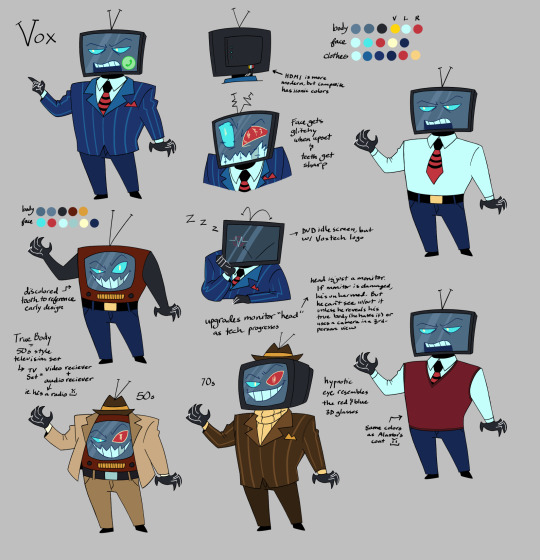

So Vox may not be my favorite character, but he is probably my favorite redesign. I laugh every time I look at him now. He looks like a weird mix of Spongebob, Kraang(TMNT), and Mr. Electric(Sharkboy and Lavagirl). He absolutely hates it.
Notes under the cut
There's too many twinks in this show. So when I was trying to decide which characters I could change, for body diversity, Vox was an obvious one. He needed more bulk so his body could conceivably support the old TV models. Those things could get heavy. The change also had the side effect of making him shorter, which just worked better proportionately.

I liked the idea that Vox could never get rid of his original bulky 50s TV, but also wanted him to be able to upgrade. So I decided his true body is the 50s TV, and he adds an upgraded monitor for a head as technology improves. He's hates that he's stuck as an old fashioned TV, so he hides that under his suit. Since the monitor is just an addition, it can be swapped out easily. It can be damaged and he's technically unharmed. But he can't see through his suit without the monitor, unless he wants to use a security camera and direct himself 3rd person style.
I didn't like that basically everyone has sharp teeth. It reduces the impact for characters like Alastor or Rosie. So I've been having the default be just sharp canines. But with Vox being a TV, there are so many possibilities. I gave Vox "regular" teeth, which helps him look more trustworthy. It fits the corrupt businessman vibe. But the appearance can change with his mood too.
Color TV became available in the 50s, so Vox always had color vision. But I think it'd be funny if, early on, he had a tendency to glitch out by going into black and white vision when he gets worked up. He's mostly grown out of that glitch, but he can't seem to shake the static or TV color bars, and developed new ones as he integrated computer and internet tech into himself as well. Now he gets the Blue Screen of Death, system errors, and city wide power surges.
Messing around with his face is so fun. When he's bored or tired a Voxtech logo will bounce around like the DVD logo, or display a screensaver. His face can get too big for the screen when he's excited, or be small when he's feeling embarrassed. I need to put a troll face on him at some point. It may be an old meme, but man, it feels right.
His left eye turns red when it's hypnotic, to reference those blue and red 3D glasses.
Of the three Vees, he is absolutely the most powerful. Val and Vel are the content creators, but Vox is the platform. The other two, while still powerful in their own right, would never have gotten to the level they're at if it weren't for Vox. He controls the mainstream media.
--TV set--
So we've got some interesting implications with how he functions. He's a TV, but he blue screens like a computer, and he shorts out the power grid. I think it's safe to say he is more than just a TV, he's a multimedia entertainment center. That, and TVs are starting to really blend with computers these days. He's mainstream media.
At some point, I realized that a TV set was a "set" because it wasn't just a single device. A television set was a collection of components, which boils down to a radio hooked up and synchronized to a visual display. I bring this up mostly because I am a sucker for one-sided radiostatic. It's so funny to me. Vox is obsessed.
But I'm going to refrain from too much theorizing about their relationship. Alastor is absolutely not interested in romance. Nor a QPR. He's not even interested in friendship. Alastor is too invested in power dynamics to really consider anyone a friend. Mimzy is probably the closest he has to a friend, and even that has manipulative elements on both sides. But I'm supposed to be talking about Vox!
--Human Vox!--
He is not tall, haha. But his proportions are a bit taller than his demon form. I wanted to go for square glasses, but I didn't see many examples of that in the 50s photos I found. Oh well! My goal was a sleazy business man. He probably had a variety of jobs, but they primarily involved TV. Commercials, PR, interviews, news, game shows, talk shows, screenwriting, etc. Whatever he could do to get more influence. He found himself favoring the business end of things. Making deals and pulling strings. He decided what would go on the air. He's one of those network executive types.
I see lots of people give him heterochromia, but I don't really see a point to that. He hypnotizes people with his left eye, sure, but it's not a different color. It's not disfigured in any way either. Maybe he just had a tendency to wink at people, I dunno.
I think his death involved some sort of severe skull fracture focused around his left eye. Maybe a car accident, maybe he was shot, idk. Maybe seizures were involved. But he was somewhere in his mid 40s to early 50s. I ended up writing 45, but I'm not super committed to that or anything.
For a human name, I see lots of people calling him Vincent and that's sorta grown on me. So I might go with "Vincent Cox".
And because I fell into another research rabbit hole...
--TV evolution--
(below) 50s-60s CRT TV: TV sets were treated as furniture and there could be some very interesting cabinet designs. Color TV was introduced in the 50s, but wasn't quite profitable until the late 60s.


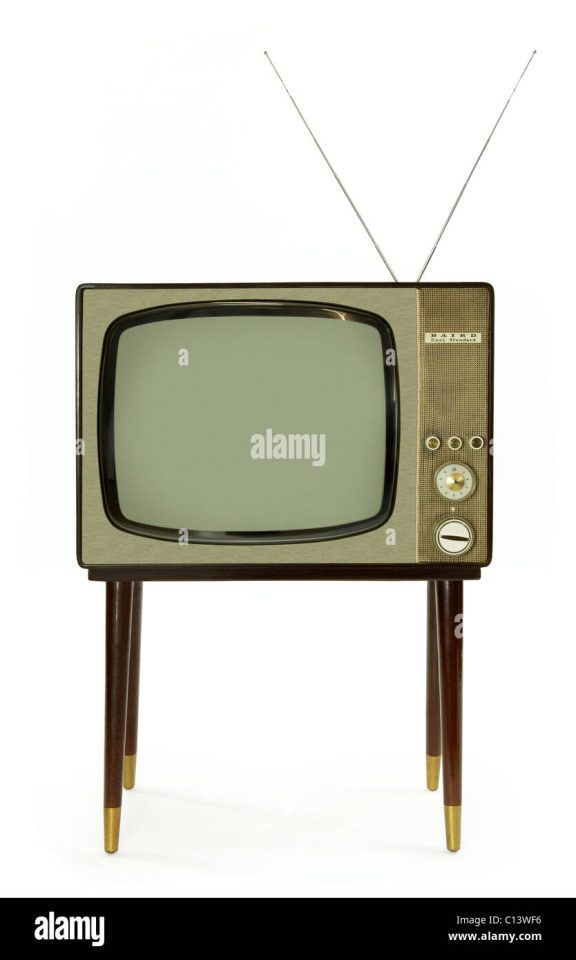
(below) 70s-80s CRT TV: Color TV became more affordable and commonplace.



(below) 90s CRT TV


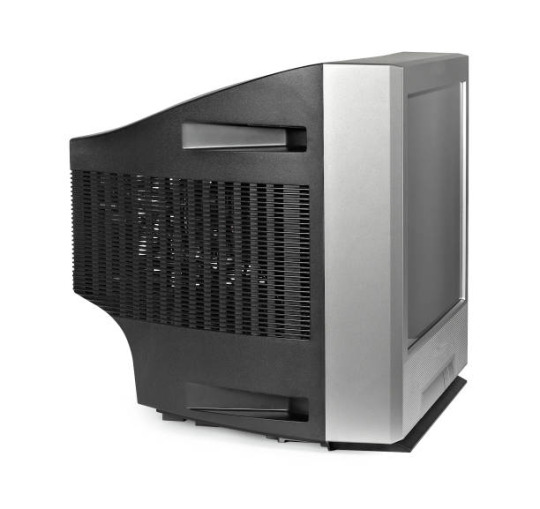
(below) 2000s CRT to Plasma and LCD TVs: The three display technologies competed, but LCD won out in the end. Plasma and early LCD didn't look substantially different. Plasma was a little bulkier, but was still slimmer than CRT.



2010s and on: LCD improved with LED backlighting. But then OLED removed the need for backlighting entirely, which mixed the benefits of plasma and LCD. (Didn't bother to find a picture example. It's so close to modern at this point)
--Display technology-- (These overviews are very simplified)
CRT(Cathode Ray Tube)--Used through the 1900s to approx 2010. Monochromatic until Color TV developed aroung the 1950s. Worked via vacuum tubes and electron gun that lit up the pixels. They were bulky, heavy, and used a whole lot of power. Widely considered obsolete and no longer made. Video games made while these were in use tend to look better in CRT, since the graphics accounted for the image quality.
Flat screens-
PDP (Plasma Display Panel): Used from early 2000s to approx 2015. Used gas cells that light up pixels when electrically charged. Good image quality and good contrast, but expensive, heavy, and used a lot of power. Considered obsolete and no longer made, despite still having a desirable image quality.
Plasma and LCD competed in the 2000s to early 2010s as CRT popularity waned. LCD eventually won out due to weight and overall cost(including market price and energy efficiency).
LCD (Liquid Crystal Display): Introduced for TV around the same time as Plasma. Works via a liquid crystal layer with a backlight. Slim, decent image quality, energy efficient. Viewing angle matters because image colors are warped at wide angles. Cheaper than plasma. There are two main backlighting types:
--CCFL(Cold Cathode Fluorescent Light): Used fluorescent lighting for the backlight. Image quality was decent, but didn't have good contrast. (the blacks were never truly dark because of the backlight)
--LED(Light Emitting Diode): An LCD that uses LEDs instead of CCFL for the backlighting. Better contrast and efficiency than using CCFL.
OLED(Organic LED): Mixes strengths of plasma and LCD. Self emitting LEDs. No backlight or LCD panel needed, which improves contrast(about as good as plasma was, which is why plasma is basically obsolete now).
--QD-OLED(Quantum Dot- OLED) Adds a layer of Quantum dots to an OLED to improve color gamut. I think. I can't let myself fall too far into this rabbit hole, so I'm not double checking anymore.
((Feb 12, 2025-updated tags)
#hazbin hotel#hellaverse#hazbin hotel redesign#hazbin vox#vox#human vox#the vees#heavenbound au#a3 art#fanart#digital art#character sheet
155 notes
·
View notes
Text
Sims In Bloom: Generation 2 Pt. 157 (Coping Without Ash)
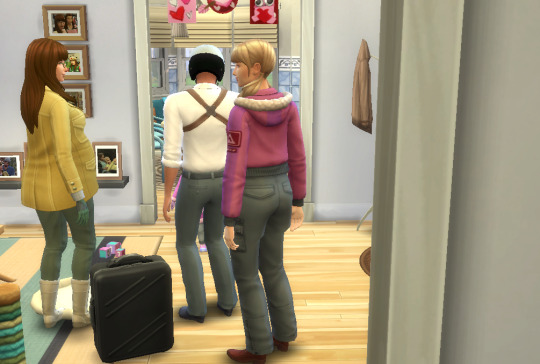
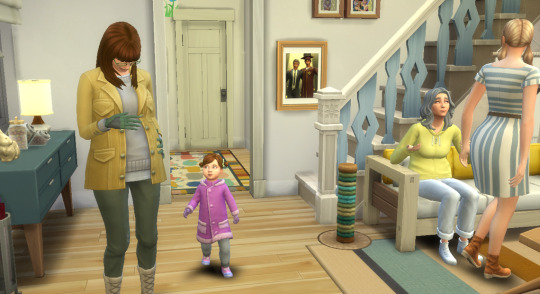
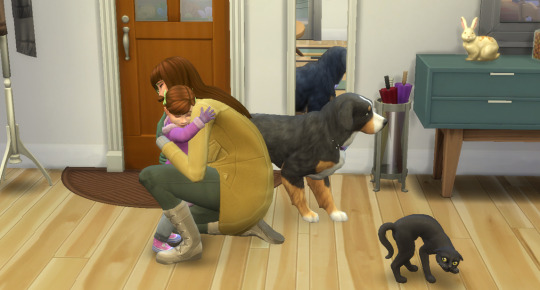


It had been almost a week since Ash's escort to the Landgraabs in the city. They weren't even allowed to call him, and Heather moved through the house in a walking haze. She forced herself to eat for the sake of their unborn child and doted on Lavender despite her depression, but she withdrew from her usual nature.
Conrad and her family were deeply concerned, and her mother, Daisy, arrived in the Bay with Holly, Betta, and a few suitcases. Heather's close-knit family was determined to help her through this, and they planned to stay until after the baby was born.

Normally, Conrad might object to packing their home with so many people and pets with a newborn on the way, but he hated seeing Heather like this. He hoped her family could help, but he knew, deep down, the only thing she needed was Ash.
"I talked to Felix today," he said, as they shared a cheesecake made by Daisy to follow dinner. Heather looked up, listening without a word. "He said he's found some interesting things during discovery, and he's confident about our hearing in San Myshuno."
"Did he say what he meant?" asked Daisy, but Conrad shook his head as Daisy frowned. "I just can't get past the Landgraabs pulling this after everything!"

Though she'd tried to hold it together for Heather's sake, Daisy couldn't hold back a sob while they gathered around the table.
"Why you sad, Gramma? Ash isn't gone for always. He'll be back."
"Of course he will."
Conrad got up from the table to clear a few plates, trying to remain strong in the face of Heather's crumbling facade. But he was processing grief in his own way over the ordeal, switching between anger and stoicism in rapid swings. (Seriously he's been all over the place.)
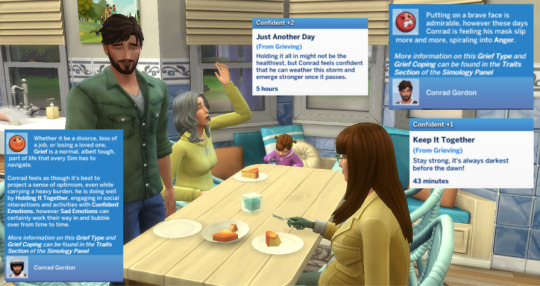
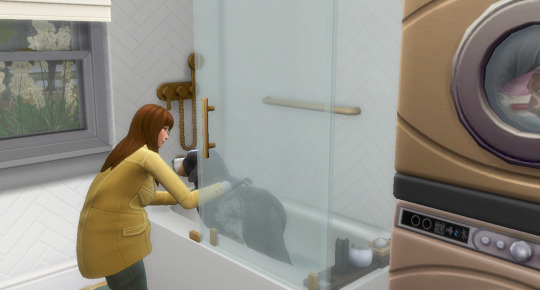


Heather went to bed early after giving Gord a bath, so Daisy and Holly hung out with Lavender and Betta when Conrad was called to a crime scene. To say they were managing without Ash around was barely accurate, but they knew they couldn't give up yet.
In Britechester, Felix and Lilith were feeling the loss of Ash's genius expertise, too. Lilith had welded the time travelling component, but now she was trying to use Ash's notes to program it to her computer and calculate a landing point. She was struggling.
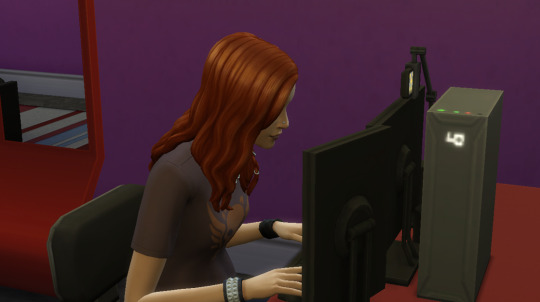
"When is the custody hearing? It'll be real nice when we can finally talk to Ash again about all this."
"Next week," said Felix, strumming a silly song on Lilith's guitar.
"Stop being a goofball for a minute and take this seriously," she begged, trying not to laugh at him anyway. "Emit thinks our tech's too primitive and doesn't know enough about it to help - if he could even find the time out from underneath my sister."
"You think they're falling for each other?"
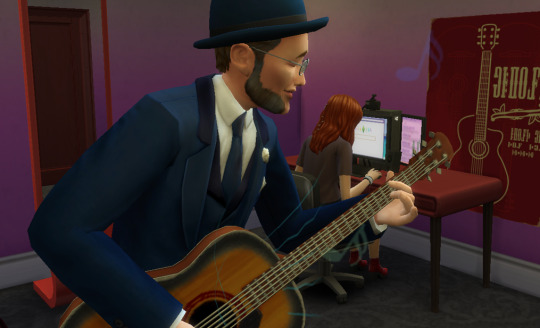
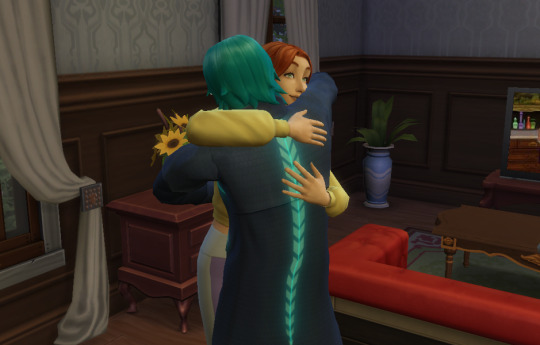
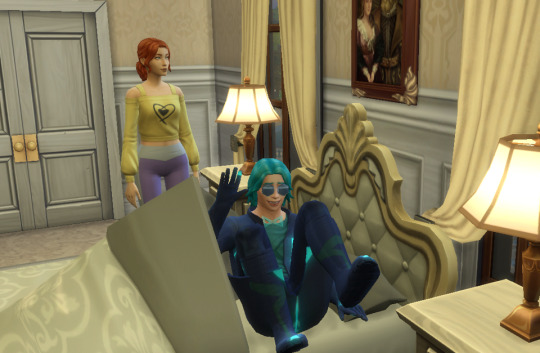
"They keep saying they're just having fun, but I know my sister. Angela wants happily ever after and she likes Emit, but she's afraid to get attached."
Felix nodded. "That's fair, isn't it? He is a time traveler, and once we help him catch his time thief, he'll go back to the future."
Lilith frowned. She turned back to her computer just as the screen flashed and turned blue, spilling code across the monitor and shocking her fingertips through the keyboard. "Dammit, I just fried it and it tried to fry me!"
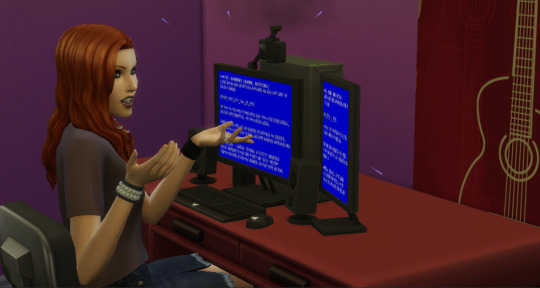
Felix put down the guitar and smiled. "It's okay, Lil. Ash has already invented time travel, we just have to prove it works. Take a break, your parents are making dinner. Then see if Emit knows anything about our "primitive" computers. I think Angela's busy working out, so you should find him unoccupied for the time being."
Lilith took his advice and headed for a soak in the tub. While she relaxed, Felix repaired the computer. He was still holding on to the engagement ring, still waiting for the perfect moment to propose. But they were too distracted lately by time travel and Ash's custody case.
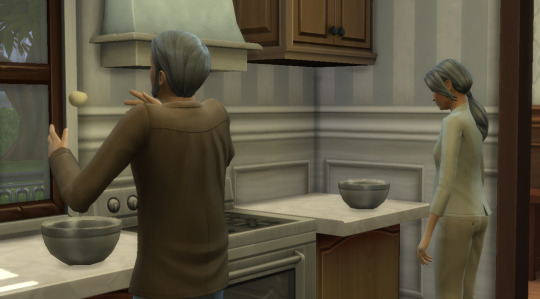
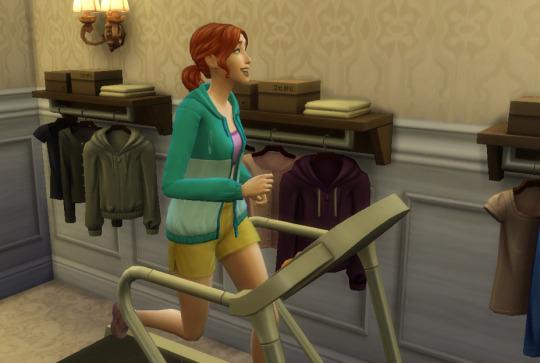
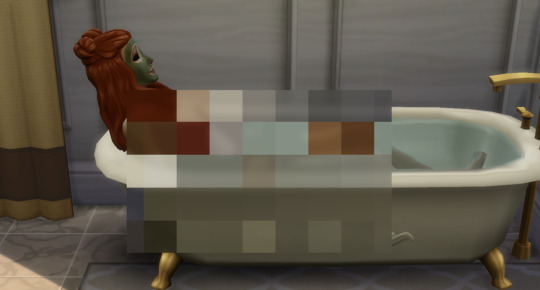
Emit did prove helpful with the computer, teaching Lilith how to overclock it to process Ash's codes and calculations.
"I can't say for sure the code's right, but I know a ten-year-old coming up with half of this is amazing. I trust the parts even I don't understand because so few in this time could know any of this."
"So you think we're almost ready to travel through time?" Lilith's earlier frustrations had turned back to hope.
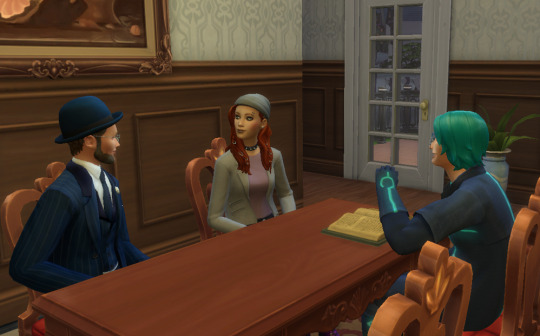
"We could leave as soon as you're done with the custody hearing. My wristboard is still tracking the time thief, but with with two working devices, we'll head them off anywhere in time they think they can hide."
With a buzz of excitement running through their veins, Lilith and Felix shared a smile and a searing kiss. "Can you believe it? As soon as Ash is back with his parents, we're going to jump through time!"
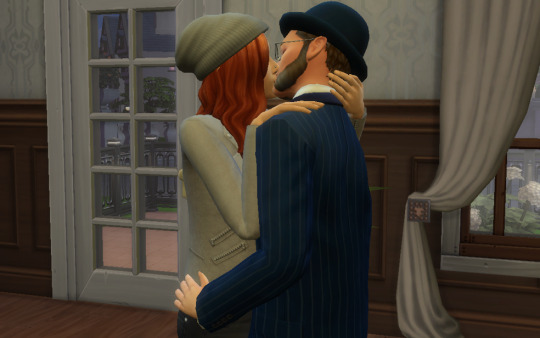
Felix had lived through more decades than he could count, but experiencing the future - or the past - with his beloved Lilith sounded like the adventure of a lifetime. ->
<- Previous Chapter | Gen 2 Start | Gen 2.1 Summary
Gen 1 Start | Gen 1 Summary
NOTE: In the interest of full disclosure, I don't know if any mods out there connect a custody battle with grief moodlets and these moodlets for Conrad actually followed the death of Ben. Heather grieved Ben, too, but she was more muted and dazed, understandably, because she didn't know him as well. But grief moodlets can be persistent and Conrad was still going through it during this time, so I mean no disrespect to Ben (really!) but I usurped those moodlets for my plot, and their grief styles informed how I wrote this arc.
#sims 4#sims 4 gameplay#sims 4 screenshots#sims 4 legacy#sims in bloom#ts4#ts4 gameplay#ts4 legacy#ts4 screenshots#sims 4 story#ts4 story#legacy challenge#sims legacy#ts4 legacy challenge#gen 2#brindleton bay#britechester#felix psyded#lilith pleasant#blast from the past event#angela pleasant#emit relevart
97 notes
·
View notes
Text
Working After Hours...
I don't use Tumblr that much, and already posted this new story over on DeviantArt. But if you haven't already read it over there, maybe you'll like it here: A happier, more positive, and longer anesthesia story! Let's see if tumblr will do 9000 words in a single post...
I power down the last computer at the registration desk. The screen clicks off.
Friday nights at Riverside Surgical Center always end like this. Just me, alone in the building; wandering the halls, making sure everything is powered off, closed and packed up for the weekend. It's my favorite part of being the sole IT support specialist here. When everyone else rushes out, I get these perfect moments alone. With the equipment.
The hum of the building's air handling system becomes noticeable as I cross the deserted, silent lobby. My footsteps click against the polished vinyl flooring. I walk to the entrance, diligently checking that the automatic door is locked closed. It is. I’ll lock it again when I leave, but tonight I don’t want any unexpected visitors.
I turn and begin my rounds through the facility. The surgical center’s manager thinks I'm dedicated. In reality, I'm obsessed.
Medical technology has been my special interest since I was a teenager. While other kids collected posters of rock bands, I hoarded medical supply catalogs. By eighteen, I could name every component of an anesthesia machine and knew the admin passwords to a handful of patient monitors. The job here at Riverside isn't high-paying, but it gives me access to a playground of sophisticated equipment that nobody outside the medical profession would get to touch.
The pre-operative area is my first stop. Six curtained bays line the wall, each containing a stretcher with accompanying vital signs monitor. I walk slowly, making sure each monitor (a Phillips model I know well) is powered down. When in use, their screens show blood pressure, SPo2 and pulse rates. They’re seldom used with ECG leads in pre-op. I notice things like that. I’ve always been into the small details.
Regardless, they’re all dark now. The monitoring system's central station sits at the nurse's desk. They’ve already turned it off.
I walk into one of the bays, and push an IV pole out of my way. Mounted on the pole is an infusion pump, its digital display dark. I check the bay's cabinets, making sure the stock of IV catheters, saline flushes, and adhesive dressings are orderly. I don’t really have to do this; it’s a med tech’s job, but… I want to.
As I check the next one, I pocket a couple of alcohol prep pads. Then a few pairs of purple nitrile gloves from the wall dispenser. Nothing that would be missed. I've been collecting “supplies” for months this way. I tell myself I’m building my own personal medical kit for home, but I know I just like having this stuff.
The staff lounge is next. There’s not really anything in here that I need to power off; we’d all be in trouble if I shut the refrigerator down. Nothing seems out of place here. It was one of the nurse’s birthdays today, and there are cake crumbs on the table. I skipped the party, but I helpfully wipe them up. There’s a box of masks by the door, though, and I take one, adding it to my scrub pockets. My heart rate increases slightly at the thought of what I'm planning later, but for now, I just turn out the breakroom’s lights.
Moving on with my patrol, I enter the post-anesthesia room; the PACU. This is more or less a mirror of pre-op, but with closer monitoring. The ECG traces on the monitors get used here. Eight recovery bays face a central nurse's station where the staff can observe all of the waking patients at once. Like pre-op, I verify each is powered down, and catch one that the nurses missed.
I pass through the automatic double doors that separate the PACU from the main corridor. My pulse quickens as I approach my actual destination tonight: the surgical suites. Riverside has three operating rooms; more than average for the facility’s relatively small throughput. Each is specialized for different types of procedures.
OR 1 is the largest, equipped for general surgery. Its boom-mounted equipment arms hang suspended from the ceiling in standby mode. The room lights are off, and the surgical lights on articulating arms are stowed neatly against the ceiling. I stare through the door for a moment, then move on.
I walk to OR 2, which is set up primarily for orthopedic procedures. The C-arm x-ray unit is parked in the corner, draped with a protective cover. Riverside sees a lot of broken arms, ACLs that need repair, and the like, but I’ve never been that interested in medical carpentry. Everything looks alright here, so I move on again.
Finally, I reach OR 3. It’s the smallest of the three rooms, sometimes used for endoscopies, but also for gynecological and urological procedures. This one has always held a special fascination for me, for reasons I leave unexamined for now. The operating table here is equipped with integrated leg stirrups, really more like giant yellow boots, that can be positioned at various angles. The table itself is computerized with both foot pedals and a remote. It can be easily moved to nearly any position, which is why I’ve chosen it for tonight.
I hesitate at the doorway, my heart pounding. The room, like the others, is dark and still. My hand finds the light switch, and I flip it. The room lights and overhead surgical lights come on at once, uncomfortably bright. I let my eyes adjust for a moment, then I step inside and let the door swing shut behind me.
This is my plan. This is the reason I’m so helpful on Friday nights.
I move purposefully. The anesthesia workstations here are slightly older than I might find in an academic center, and frankly, that’s what I want. It still has physical knobs that I could twist, instead of a touchscreen. I approach it; running my fingers along its smooth surface. I think, just for a second, how embarrassed I’d be if someone saw me basically petting the machine. But I’m alone. That’s the point.
On the far side of the operating room is an entire wall of supplies. Opening a cabinet, I locate the components I need. A disposable breathing circuit, nicely packaged with a filter and a gas sampling line. A pair of rebreathing bags, and an adult-sized anesthesia mask. In another cabinet, I find a four-point head harness, designed to keep the mask securely in place during procedures. I lay these items out methodically on the anesthesia machine's work surface.
Next, from a different cabinet I retrieve a pulse oximeter sensor, and a blood pressure cuff. I return to the anesthesia workstation, and connect both to their respective ports on the machine. Even if I didn’t know where they went, the plugs are colored and fit only in the right place. It just takes a few seconds, despite my slightly trembling hands. I think about getting ECG pads; the machine is already setup for 5-lead, but I decide it’ll be too awkward to manage the wires.
I connect the breathing circuit to the outlet and inlets on the anesthesia machine, carefully attaching the corrugated tubing and the rebreathing bag. The mask will go at the end of the circuit, but for now, I just slightly inflate the plastic seal around the mask’s rim with a syringe, then I lay it down on top of the machine
I press the power button on the anesthesia machine, listening to the startup sequence of beeps and watching as the ventilator performs its self-test. When it’s done, I perform a machine check, following the same protocol the anesthesiologists use each morning. I verify that oxygen flows properly from the wall outlet through the machine's pipelines. The backup oxygen cylinder shows pressure on its gauge. The nitrous tank is open and full. I check the carbon dioxide absorbent canister; it's fresh, the granules still white instead of the purple that would indicate it’s all used up. This is good, because I’m not actually sure which cabinet would hold a replacement, and I don’t want to search.
It takes a few minutes, but the checks complete cleanly. The rebreathing bag inflates and deflates properly and everything holds pressure. I slip the mask onto the business-end of the anesthesia circuit, pressing it in place firmly.
This machine, I note, has two vaporizers on it, purple and yellow, iso and sevo. I don’t plan to use these, but I see that the liquid level indicator on the sevoflurane shows about a quarter full. I’m intrigued but volatiles are far too dangerous to mess around with.
With the electronic foot pedals, I adjust the operating table to its lowest height setting and position it at a slight incline, so I can sit comfortably on it. The table’s dual armboards easily fold down, out of the way completely. I’m relieved to see the stirrups are likewise folded down; I'll have no need for those tonight. When I’m done, the operating table resembles a very expensive, very black chaise lounge.
I wheel the anesthesia machine closer to the operating table, careful not to pull the gas supply hoses too far. With some effort, and a couple more change to the operating table’s pitch, I position it where I can just about reach the machine’s controls, while seated on the table.
I shimmy to the center of my operating-table-made-chair. I smooth out the sleeve of my left arm and wrap the blood pressure cuff around my own bicep. It’s awkward. I struggle with the Velcro, trying to get the cuff closed in the right place on my arm, and to tighten it appropriately. After a few attempts, though, I get it close enough. The pulse oximeter clip goes easily onto my right index finger, and rhythmic beeping starts to track my heartbeat. I reach to the anesthesia machine, and using my middle finger to put the button, start the cuff. Within seconds, the monitor displays my vital signs: heart rate 92, blood pressure 138/84, oxygen saturation 99%. My elevated heart rate and blood pressure doesn't surprise me. I've been fantasizing about this whole thing for months.
I reach out to the machine’s controls and set the oxygen flow rate to 6 liters per minute. The flow meter's ball rises in its chamber, indicating the gas is flowing as expected. The room fills with a quiet hiss.
I pick up the mask, and I feel a momentary hesitation. What I'm about to do crosses a line, from a special interest to something more dangerous and much more against the rules. But the temptation is too strong to resist. I've come this far, after all.
I bring the mask to my face, feeling the soft plastic seal against my skin. It's cool at first, but quickly warms against my face. I take a deep breath, smelling the significant plastic scent of the new breathing circuit and mask. The oxygen fills my lungs.
I pickup the black head harness, and, with a little more awkwardness, I secure the mask to my face, tightening the straps until it stays sealed tightly even when I’m not holding it.
My breathing sounds loud inside the mask. For a few moments, I watch the rebreathing bag inflate and deflate rhythmically with each breath I take. I watch my oxygen saturation maintain at 99% on the monitor. Everything is working perfectly. It’s time to take the next step.
I reach for oxygen flow knob again. This time, it twist down… and twist the nitrous oxide tap open. I know how the flowmeters work, and set the balls to a roughly 33% nitrous oxide flow. I take a deep, deliberate breath through the mask, and the effects begin almost immediately. A pleasant warmth spreads through my limbs. I hold the breath for a second, then deliberately take another very big breath. My fingertips tingle with a curious numbness. By the third breath, a buzzing sensation starts at the base of my skull, radiating upwards into my head. I’m surprised, and more than a little bit pleased, at how fast I’m feeling the nitrous. I've read about this feeling countless times in medical literature and online, but experiencing it firsthand is amazing; both the physical sensation and the forbidden nature of what I'm doing. I want more. I turn the oxygen down slightly again, and the nitrous up.
I lean back onto the operating table, letting my arms fall to my sides, and take in more of the gas as I relax.
The room maintains its sharp edges and clinical brightness, but my perception of it begins to shift. The surgical lights above me seem more intense, their glow extending just a bit beyond their actual boundaries. The rhythmic sound of the gas flowing through the circuit becomes hypnotic. My breathing is less intentional now, but even so, I’m still breathing slowly and deeply. The rebreathing bag inflates and deflates and I enjoy watching it for a couple of minutes. Inhale, exhale. Inflating, deflating.
I check the monitors with slightly unfocused eyes. My heart rate has decreased to 84 beats per minute; it’s still elevated from my normal resting rate but lower than before. My oxygen saturation remains good. The blood pressure reading cycles automatically every five minutes. The cuff tightens around my arm before letting go with a soft hiss: 125/76. The beep of my heartbeat has slowed.
I laugh, muffled by the mask. I watch the rebreathing bag some more.
The blood pressure cuff cycles again; time is stretching, I’ve floated here five minutes already, and dissociated without realizing it. There’s a clock on the OR wall, and I watch it for a minute. It moves simultaneously slowly and fast. I smile. I’m happy, and… I want more.
I decide to increase the concentration. My movements are deliberate, almost ceremonial, as I pull myself upright, then reach out to adjust the flowmeters. I’m already around 50%, and I want a bit more. I twist the nitrous upwards, nearly as high as it’ll go. I can tell the difference almost immediately.
The buzzing in my head intensifies, becoming a gentle vibration that extends through my entire body. The boundaries between myself and the room begin to blur. The operating table beneath me seems to become softer, much softer, as if I might sink through it if I relaxed completely. I don't, though; I still have the presence of mind to lower myself back onto the table gently, instead of falling off.
I let myself drift again. I think about the nurses and surgeons who work in this room, wielding their instruments, controlling life and consciousness with practiced hands. Now I'm doing the same, in a way. This thought seems somehow hilarious and profound. I don’t start laughing but I’m pretty close. Before I know it, the blood pressure cuff is cycling again.
I raise my hands in front of my face, fascinated by how distant and blurry they seem. I wiggle my fingers, watching the movement with detached curiosity. There's a delay between my intention and the action, as if I'm connected to a video game on a bad internet connection. I slide my palm along the cool surface of the operating table, the sensation of touch seems simultaneously intensified and muted.
A new thought surfaces through the haze of nitrous oxide: what would sevoflurane feel like? I know that nitrous, at normal pressure, can’t actually knock anyone out. But sevo, at even at moderate concentrations, induces unconsciousness within minutes. I don’t want that. Even while intoxicated, I clearly understand the consequences of gassing myself to far. But my understanding of MAC is that at lower concentrations, like, say, 1% or 2%, people my age will generally remain awake. At least for a little while.
I could try it. Just a little.
I know it’s dangerous, but the idea is irresistible.
I sit up again, and reach for the anesthesia machine, my movements a lot less coordinated now, through the nitrous fog. First, I turn down the nitrous oxide flow to zero, allowing pure oxygen to clear my system for a moment. I take several deep breaths, feeling some of the fuzziness recede. My thoughts sharpen enough for me to recognize the recklessness of what I'm about to do, but not enough to stop me.
I turn the yellow vaporizer dial just a bit, turning it to 1%, then to 2%. Enough to taste it, to feel its initial effects for real. I’m not feeling tentative now, like I was with the nitrous, even though I know I’ll need to quickly turn it off. I breath all the way out, and the sevo begins to flow.
The first breath is still mostly oxygen, and I let myself settle back onto the table. When I take the second breath, though, a distinctly sweet smell fills the mask. It smells chemical, like a harsh cleanser, but… not unpleasant. I don’t feel anything. I take another careful breath, then another. Only then, does the effect hit me.
A heavy warmth spreads through my body, like someone’s thrown a weighted blanket over me. Another breath, and I start to feel distinctly tired. The nitrous made me feel fuzzy primarily, this is making me feel drowsy.
I try to breath normally, and the edges of my vision begin to blur, the periphery darkening slightly. It’s as if a camera’s vignette effect has been applied to my eyesight. The beeping heartbeat sound in the room seems to recede, becoming muffled and distant. It’s much more intense than the nitrous, and much more intense than I expected. I understand, in a moment, how stupid I’ve been. I need to turn the gas back off.
I sit up, trying to reach the machine, and it feels like I’m moving through syrup. My intention to move my hand doesn’t match my muscles exactly; the same effect as the Nitrous but more severe. The machine seems farther away than it was a moment ago. I reach for the vaporizer dial, and my own hand seems disconnected, as if it’s not mine.
Before I can reach the dial, another hand appears in my peripheral vision. A hand that is, for sure, not mine.
I try to turn my head, movements sluggish, brain struggling to process this unexpected development. A figure in blue appears, standing beside me, and grabs my wrist, pulling it back from the vaporizer.
"What have we here?" a female voice says. "Someone's been playing with toys they shouldn't touch." The words have a British accent, and seem to echo strangely in my ears.
I start to speak, but the mask is still harnessed to my face. I try to reach up to remove it, but the woman grabs my other wrist, too.
In the harsh surgical lighting, I see it’s a woman in blue scrubs, a surgical cap covering reddish hair, bright eyes above a white surgical mask. It's a nurse, but in my disoriented state, I can't immediately identify which one. Panic cuts through the chemical haze. I wasn't supposed to be discovered. No one should be here. The staff all left. I made sure of it.
I’m not sure what to do. I try to stand, to pull away, but my reactions are dulled by the anesthetics already in my system. The sevoflurane continues to flow; I still haven't turned it off, and each rapid, frightened breath draws more of the agent into my bloodstream.
"Turn it off," I manage to say, my voice muffled by the mask. "Let go of me!"
"I don't think so," the nurse replies. I feel myself being pushed backwards, down onto the diagonal operating table. "You've set everything up so nicely. It would be a shame to stop now."
I'm larger than her, stronger under normal circumstances, but the sevoflurane has substantially undermined my coordination. She pushes me down easily. But I’m not done yet; I turn sharply, trying to break her grip, and succeed in pulling one arm free. I reach for the mask, intending to tear it away, but she’s fast, or I’m slow. She blocks my hand, catching my wrist again.
"Oh no, you don't," she says, her voice hard. "Keep that mask on."
Fear spikes through me. Each breath is drawing more sevo into my system. I thrash, but the head harness keeps the mask firmly in place despite my movements, and the continuing supply of anesthetic makes my fight increasingly clumsy.
The nurse adjusts her grip, pinning one of my arms under her body, while reaching for something on the anesthesia machine I’ve placed so conveniently close by. To my horror, I see her turn the sevoflurane vaporizer not down, but up. I can’t see where she’s set it, but I know anywhere above 3% will rapidly render me unconscious.
"No!" I shout this time, the word completely intelligible even through the mask. I buck upward, pressing my legs against the table, trying to get up. For a moment, I think I might break free. The pulse oximeter rips free from my finger, setting off a high-pitched alarm from the monitor.
I’m able to slide my right arm free of the tangle of limbs, and I grasp at the mask, fingers scrabbling at the head harness, but they just… won’t… get it… My fingers don’t work right.
The nurse recovers quickly, catching my free wrist a third time, and forcing it down. She swings one leg over me, straddling my chest and fully jumping on the table. Before I know it, she’s on top of me. She’s using her weight to pin me down. Her face is close to mine now. It’s aggressively intimate, her blue eyes intense above her mask.
"Don't struggle, love" she says, her voice simultaneously soothing and menacing. "You'll only make it worse for yourself."
With her full weight on top of me, my movements grow increasingly fruitless. Even if she wasn’t on top of me, the feeling of heaviness, the feeling that started after my first few breaths, is much stronger now. Each time I try to push her off, the physical exertion forces me to breathe harder, deeper, pulling more sevoflurane into my system. I realize that the more I fight, the faster the anesthetic is taking hold.
My vision begins to waver, the straight lines of the room twisting and bending. The nurse's face above me seems to split and rejoin, her mask and eyes turning blurry and confusing. I blink rapidly, trying to clear my head, but my eyelids are harder and harder to open each time I do. It doesn’t help at all.
"You're quite strong," she comments, sounding slightly out of breath, but in control. "But the sevo is stronger, love. Always wins in the end."
My strength is failing rapidly now. My arms feel impossibly heavy, as if I’ve been tied down with giant elastic bands. I still struggle, but my movements are feeble, uncoordinated. I’m losing.
The room begins to spin in slow, nauseating circles. The lights overhead multiply, separating into a rainbow of colors. My hearing seems more affected now too: the nurse's voice echoes strangely, as if coming from multiple directions at once. The alarm from the disconnected sensor sounds distant, as if I’m underwater.
I'm aware of my breathing becoming slower, deeper.
"That's right," the nurse says, her voice drifting to me through layers of distortion. "Stop fighting now. You're doing so well."
I watch the nurse as she climbs off of me, but somehow, her weight seems to stay. She maintains her grip on my wrists for another few seconds, but my arms have gone limp. She releases them cautiously, maybe prepared to restrain me again if I’m faking it, but I am very much not faking it.
I can barely lift them now. My eyelids feel impossibly heavy. I force them open only with tremendous effort, trying to focus on her face, but my vision is degraded, or my brain won’t control my eyes. I can’t tell which. I try to think of something to say, but I can’t.
"Good," she says, her tone shifting to something almost… sexual. "You're submitting beautifully now."
I hear the sound of electric motors as she repositions the table, I feel myself tipping backwards. She’s straightening my legs, raising the table, returning it to a flat configuration. She gently places my arms at my sides. I want to resist but can only manage the weakest of movements.
The nurse moves to the anesthesia machine, adjusting something I can't quite see. The sevoflurane concentration, I realize distantly. She's increasing it again. The time I breath, the gas rushes in forcefully, making me breath fully and deeply. She’s squeezing the rebreathing bag.
"Just close your eyes and drift off now," she orders, her voice seeming to come from very far away. "It’s dreamland for you."
My eyelids flutter. No amount of effort can keep them open. I realize with a distant sort of horror that I'm about to lose consciousness. I make one final, feeble attempt to sit up, to roll off the table, but my muscles refuse to cooperate.
A strange feeling of peace begins to replace my fear. The inevitability of going under becomes almost comforting. I can no longer remember why I was fighting so hard against this feeling. I’m so incredibly tired and I just want to sleep. With each breath into the mask, it gets stronger.
"Perfect," she murmurs, watching as my resistance fades completely. "That's exactly right. Let it happen." I hear her, but I don’t understand.
I can’t see the nurses’s face anymore, as spinning blackness rushes in from the edges of my vision. Yet somehow, I know she's smiling as she watches me fall down to oblivion. The world clicks off.
I drift up through darkness. Consciousness returns in fragments as my brain boots up.
First comes the sensation of touch: cool air on bare skin, pressure around my wrists, on my back, on my thighs and ankles. A moment later, my sense of position; proprioception. I’m on my back, my arms splayed outwards, my legs in a strange position.
I try to rub my eyes, but the pressure on my wrists keeps them from moving.
It takes several seconds, maybe a whole minute, to process what just those two senses are reporting, what all that means. I'm lying on my back, restrained somehow.
Next, I hear a steady beeping. It’s increasing in speed as I wake up. No memories yet, but the sound seems familiar.
My eyes are closed. Only with some effort am I able to force them open. As soon as I do, I blink against harsh, circular lights overhead. Surgical lights. The operating room comes into fuzzy focus, and with it, my fragmented memories.
I'm completely naked, immobilized, and splayed open on the operating table. I remember being caught, overpowered.
My mouth feels incredibly dry. I try to swallow but barely produce enough saliva. My whole body feels sore, like I’ve just run a marathon or fought a wrestling match, which, in a way I did.
I try to move my arms again, turning to look at my wrists restrained to the table’s perpendicular armboards. I’ve seen Velcro positioning straps used here before, the kind intended for patients at risk of pulling out IVs or simply moving too much while anesthetized for surgery. The restraints here are not those, but padded leather cuffs that more resemble something from a 1950s insane asylum. I don’t know where they came from, but I’m not sliding out of them any time soon.
I lift my head slightly, fighting against residual dizziness, and look down the length of my body. As I feared, I’m completely naked; my clothes and underwear both gone. ECG electrodes have been placed on my naked chest. That’s not good.
Much worse, my legs are elevated and separated, positioned in the yellow leg-lifting stirrups that hold my feet and ankles. I'm in the lithotomy position; as if someone’s positioned me for a gynecology, urological, or rectal procedure. I try to pull my feet down, but unsurprisingly, the yellow boots and straps are tight and strong enough that it’s useless. A strangled noise escapes my throat as I realize how completely vulnerable I am. My heart beats faster and I hear the heartbeat monitor on the anesthesia machine match it. I try to stay calm and finish examining my situation. I’m not going to find a way out by panicking.
I don’t see any people around, thankfully. But it’s obvious the room has been transformed since I lost consciousness. The anesthesia machine has been pushed back to its usual position above my head. I can stretch to see it; its displays glowing with data, my heart rate, blood pressure, oxygen saturation, and now ECG and respiratory traces.
My eyes dart around the room, taking in details that send fresh waves of adrenaline through my system. Surgical instruments have been arranged on a Mayo stand beside the table; gleaming metal specula, retractors, forceps, and scissors. An electrocautery unit sits ready, its grounding pad visible but not yet attached to my body. A black endoscope is coiled on a blue-draped table nearby that I’m sure wasn’t there before. Everything is positioned as I’ve seen it used during the work week, all as if in preparation for an actual procedure. Or more than one procedure.
I remember the clock on the OR wall. It reads 6:17 PM. I try to remember when I started my self-administered anesthesia experiment; the surgical center closed at 4, so it couldn’t have been long after 5:00. More than an hour has passed that I can't account for. An hour during which someone, the nurse who caught me, has prepared this nightmarish scenario.
The door to the operating room swings open, and she enters, as if summoned by my thoughts. Now that I can think clearly, I know who this is. It's Nurse Evelyn, the British transplant who joined the surgical center staff six months ago. I suddenly recall it was her birthday cake crumbs I cleaned up an hour or so ago.
She’s fully attired for the OR now, a disposable yellow isolation gown tied over her scrubs, her hair tucked completely under a bouffant cap. No hint visible of her red locks anymore. Her hands are white latex.
Her bright blue eyes above her mask crinkle at the corners, suggesting the smile I can't see.
"Ah, you're awake," she says, her accent pronounced as she approaches the table. "Welcome back to the land of the living. How are we feeling, then?"
"What the hell is this?" I croak, my voice hoarse. "Let me go right now!"
Nurse Evelyn tilts her head, studying me with amusement. "That's not a very diplomatic way to address the person who caught you abusing clinic equipment, is it? You're in quite a sticky wicket. Imagine what administration would think if they knew you were playing doctor after hours."
She moves to the anesthesia machine, checking the displays as if we’re in a normal, professional situation. "Your vitals are stable. No worse for wear, I think. How’s the nausea?" I have no nausea, thankfully, but I don’t answer.
"Why am I restrained? Why am I…" I can't even say it, the vulnerability of my naked, exposed position.
Nurse Evelyn laughs, the sound light and warm despite the circumstances. "Why are you strapped down and undressed? Self-preservation, love. Couldn't have you waking up and bolting before we had our little chat."
"As for the stirrups, well, I needed to conduct a thorough examination while you were under. Very thorough. I had to make sure you were healthy enough for what I have planned, you understand."
Heat floods my face as the implication sinks in. I think she’s joking, but I have no way to really know. "You had no right…"
"Rights?" she interrupts, stepping closer to the table. "Let's discuss rights, shall we? Did you have the right to use the anesthesia machine on a lark? To use controlled substances for your personal entertainment?" She leans over me, her eyes intense above her mask. "No, you didn't. But I understand why you did it. We're not so different, you and I."
"What do you mean?" I ask, trying to keep my voice steady despite my racing heart. The beep of the heart monitor betrays me.
"I saw how you set everything up. The care you took with the preperation. The way you monitored yourself." She runs a gloved finger along my forearm, a strangely gentle and intimate gesture. "I think you’ve been planning this a long time. And I also think you weren't just curious about the physical sensation. You wanted to experience the vulnerability, the surrender of control. The submission."
Her assessment hits uncomfortably close to the truth. I don’t know what to say to her. She’s not exactly right, but it’s frighteningly close. There’s for sure some connection between the equipment I’m especially interested in and intense power dynamics; anesthesia has, along with it, the requirement to complete surrender to another's care. I, of course, don’t voice this, but my silence speaks volumes.
"While you seem to enjoy being the patient," she continues, "I prefer the other role. The one who decides what needs to happen. When consciousness begins and ends. The one who holds complete power over another human being." Her eyes glitter. "Quite the perfect match, wouldn't you say?"
"You're crazy," I whisper, though I think I don’t really mean it. I think she can tell that I actually do understand. I feel something inside me; not just fear, but a flicker of dark excitement I don't want to acknowledge.
"Crazy? No. Unconventional, perhaps." Evelyn moves to the foot of the table, between my spread legs, and I feel a fresh wave of vulnerability. "Here's what's going to happen. It's Friday night. No one's due back until Monday morning. You and I are going to this entire weekend exploring our mutual interests. I’ll send you under in various ways; different medicines, different combinations. I was an anesthesia nurse in England, you know. I'll take care of you quite professionally, of course."
"You can't just keep me here," I protest, though my voice lacks conviction. "People will look for me."
She raises an eyebrow. "Will they? The solitary IT worker who avoids social interaction and lives alone? Will anyone call on you?” I don’t answer, and again my silence speaks. “No. You're not due anywhere until Monday morning. Same as me."
I struggle against the restraints, panic rising again. "This is kidnapping!" I protest. It’s not halfhearted; I’m genuinely scared, even if that’s not the only emotion anymore.
"It’s hardly kidnapping," she counters smoothly. "You mostly did this to yourself. I just… helped you a bit.”
What you should realize now, love,” she continues. “Is that I could easily report what I caught you doing. That's career-ending at minimum, maybe even criminal charges." She leans over me, staring into my eyes. "Or, we could have a mutually beneficial weekend. You get to explore your fascination with anesthesia in ways you never could alone. I get to practice my skills and indulge my own… interests."
Her gloved hand rests on my thigh, the touch clearly intended to be suggestive, intimate. "Do we understand each other?"
I stare up at the surgical lights, my thoughts racing. The situation is surreal, terrifying, and yet… I can't deny the dark thread of excitement growing under my fear. Part of me has always wondered what it would be like to fully surrender to anesthesia in the hands of someone who knows what they're doing. To let go completely.
Something in her tone, in the absurd situation itself, makes a hysterical laugh bubble up from my chest. "This is insane."
"Perhaps," she agrees, "but I think it's exactly what you wanted. Just not how you expected to get it."
"What exactly are you planning to do to me?" I ask, my voice steadier now.
"I’m going to put you to sleep again," Evelyn tells me. "I’ll try different induction techniques. A sevo mask induction, as you've already experienced. We’ll try the isoflurane, too, I think. A standard propofol induction. Certainly ketamine in some combination. Perhaps etomidate, if I decide you’ll risk the side effects" Her voice takes on a dreamy quality. "I’m told each one feels different going under."
I swallow. “You can’t just anesthetize me over and over,” I object, but I don’t think I’m convincing.
She doesn’t seem convinced. “It’s definitely not recommended. But neither is the scheme I caught you playing out, is it? There are some risks, but you’ve already been taking some of those, haven’t you? I’m sure you’ll be able to handle it.”
I swallow hard, looking down at my spread legs. "And the position I'm in now? The surgical tools?"
"I think it's better if I don't explain everything I have planned," she says, voice dropping to a near whisper. "Fear of the unknown heightens the experience, doesn't it? You’re vulnerable. Exposed. At my mercy." Her eyes crinkle as the heartbeat tone speeds up. "All I’m going tell you is that you won’t feel a thing."
Nurse Evelyn leans closer. "If you cooperate, though, this could be quite pleasant for you too. Some patients report euphoria, lovely dreams. You may even find the experience… arousing." Her tone drops on the last word, sending an involuntary shiver through me.
I close my eyes, weighing my options. While she’s implied I have a choice, I suspect there really is none. She has me literally and figuratively tied down. Fighting seems pointless; she controls the drugs, the restraints, everything. But I’m not ready to trust her, even with the desire she’s ignited below my fear.
“Please, just let me go,” I protest again. But I’m not sure if I really mean it.
"I don't think you mean that, love" Evelyn reads my thoughts, her voice dropping to a husky whisper. She moves to stand beside me, her white gloved fingertip tracing a line from my collarbone down my naked chest, all the way to my waist. "I think you're just scared to admit it."
The latex of her glove feels cool against my skin. I shiver again, and my breath catches involuntarily. Evelyn leans in close. I can feel her warm breath through the mask she’s wearing. She whispers in my ear.
"You enjoyed it, didn't you? When I caught you… when I held you down… when I made you breathe in the gas until you couldn't fight anymore."
My pulse quickens, betraying me on the monitor with an accelerating beep. My memories replay as she describes them; her weight on my chest, my useless struggle, the sweet smelling gas filling my lungs against my will. I realize, to my horror, that I’m getting noticeably aroused thinking about it.
"I saw your eyes before they closed," she continues, voice silky and intimate. "That moment when fear gave way to something else. When you realized you couldn't stop it happening. You want that feeling again, don’t you?" I don’t answer. My mind races. I can’t help but feel she’s right. But I think about all the surgical tools laid out. And I don’t trust that I have a real choice here.
"You're going to put me under again no matter what I say, aren't you?" I finally ask.
"Clever," she says approvingly. "You'll be spending quite a bit of time off with the fairies this weekend. But how pleasant that time is, and how pleasant the time in between is, depends entirely on your attitude."
She moves to the head of the table, starting up the fresh gas flows. "Shall we begin? Don’t answer. You’re right, you don’t have much of a choice. A little nitrous again to start, I think."
Despite everything, I feel my resistance beginning to crumble. The fear remains, but alongside it grows a perverse curiosity. What would it be like to experience all those different anesthetics, administered by someone who knows exactly what they're doing? I think I’m going to find out.
She lowers the mask towards my face, holding my chin only lightly with her gloved hand. I move my head to the side, trying to avoid the mask. It's a futile gesture, but some part of my brain, maybe the majority, still rejects the idea of submitting so. The mask follows my movement, and her grip on my chin tightens.
"Let’s have no foolishness," Evelyn scolds, her tone sharpening.
She presses the mask firmly against my face, creating a tight seal. "Deep breaths now. Be sensible."
Against my better judgment, I feel myself relaxing slightly. The fact that it’s all being decided for me is strangely reassuring, even as the situation remains profoundly frightening. I do as instructed, and begin to breath, deeply.
She turns the nitrous oxide flowmeter, and I hear the gas begin to hiss through the circuit. "Just breathe normally. Fifty percent to start, I think. You'll feel it soon enough."
I inhale obediently. I can’t really smell it, but within moments, the familiar warm tingling begins in my extremities, slowly spreading inward. The steady beeping from the pulse monitor starts to slow.
"There you go," Nurse Evelyn says, her tone suddenly soothing instead of sharp. "Just like that. Nice deep breaths."
The nitrous works quickly, creating the same vibrating sensation I experienced earlier. The fear fades, replaced by a slight detachment that makes my situation seem less threatening, more surreal. The restraints around my wrists and ankles no longer feel quite as imprisoning. I forget about my nakedness after a few more breaths. My head starts to feel fuzzy, as if cotton is being stuffed into my brain.
"Good?" she asks, watching my face closely. I nod, unable to deny the pleasant sensations washing through me. I try to organize my thoughts. The gas already makes it difficult to think critically, but the fear and desire still war within me. Evelyn watches me with those intense blue eyes, monitoring my response to the nitrous oxide. She seems to know exactly what she's doing with the anesthesia equipment. Professional. Controlled.
Can I trust her? She's holding me captive, but there's something oddly reassuring about her dominance. She’s confident, and she clearly knows what she's doing. But she's also clearly unhinged, willing to cross professional and ethical boundaries without hesitation.
Just like I am.
I really did want this, in some way.
"Alright," I say finally, my voice muffled by the mask. "I'll cooperate."
Her eyes light up with genuine pleasure. "Brilliant! I knew you'd come around. We're going to have such fun together. I think we have a bit more to do tonight, but it’ll be over before you know it.”
I wonder exactly what she means, and exactly what she’s planning for me, but I don’t have time to ask.
"Now we'll add the sevoflurane. One percent to start." She adjusts the vaporizer dial. "This will be just like before, only now I’m in control the whole time."
The distinctive odor of sevoflurane mingles with the nitrous oxide. My eyelids grow heavy again, the room's edges softening. Nurse Evelyn secures the mask with the harness, which I hadn’t realized was already behind my head.
“Now, love, with both sevo and nitrous, you’ll go off quickly,” she explains. I know there’s a phenomenon where having both nitrous and a volatile on at once increases the effects, but I can’t remember if 1% is already enough to anesthetize me.
I’m starting to feel more drowsy. Like before, the nitrous made me detached, but the sevo is making me want to sleep. I force my eyes wide open, trying to stay awake as long as I can.
“Up to three percent,” Evelyn’s voice seems distant and echos in my ears. I know that’s enough to put me out. The visual hallucinations begin immediately. The vignette effect from before returns, my vision narrowing. The lights begin to wash out, strange colors begin to fade in. When Evelyn leans over me, her white mask seems to glow. The yellow color from her isolation gown seems to stretch out around the room.
"Time for dreamland again. Why don’t you count backward from one hundred?" she instructs, increasing the sevoflurane concentration. I can’t see how far, but the smell increases significantly.
"One hundred… ninety nine…ninety eight…" My voice sounds distant to my own ears, the words slurring together. I look up at her and her face seems to distort. The room begins to spin. The yellow of her gown changes into a confusing medical rainbow, yellow, blue, white, green, along with nameless colors that don’t exist in normal reality.
Nurse Evelyn's gloved hand rests gently on my forehead, a gesture that might be comforting under different circumstances. "You’re doing brilliantly. Keep going."
I’m supposed to be counting.
"Ninety seven… ninety six… ninety five…" The numbers come with increasing difficulty. I already can’t remember what number I was on. Have I made a mistake? My tongue feeling thick and uncooperative in my mouth. The ceiling above me seems to spin faster, expanding and contracting with my breathing.
"Nine…" I manage, though I can’t hear myself. I'm no longer sure if I'm speaking aloud or just thinking the numbers. What was I counting?
"Almost there," she encourages, her British accent barely penetrating my mental haze. "Just slip off again."
The room begins to spin faster, Nurse Evelyn's face above me, already blurred and stretched, begins multiplying and rejoining like a kaleidoscope image. I try to raise my hands, to pull the mask off. One last moment of confusion. Of course, the restraints don’t let me move at all. I’ve been helpless this whole time.
"Perfect," she murmurs down at me. My eyes close of their own accord. My body relaxes. The spinning, the drowsiness, the sense of weight over my body is all too much to fight.
Consciousness fades even faster now. Darkness takes me again. My brain turns off.
My head throbs. I realize I’m awake. I don’t remember going to sleep. I try to open my eyes, but my eyelids feel impossibly heavy. It occurs to me that maybe they've been taped shut, but I don’t know why that thought comes to me. A mechanical beeping lines up with the throbbing in my head. Rhythmic. Familiar. A patient monitor? I shift and it feels like I’m in a bed. Somehow, I think I'm in a hospital bed. My mouth feels like it's stuffed with cotton, my tongue thick and clumsy. I try to swallow, but produce barely enough saliva and my throat is sore. The details of how I got here elude me, for the time being.
It takes a minute, but I finally manage to force my eyes open, only to immediately squint; above me are harsh, fluorescent lights. White, institutional ceiling tiles come into focus. They also seem familiar.
With effort, I raise my right hand to rub my eyes, and feel a tug. Looking up, I see an IV catheter secured to the back of my hand with section of transparent tape. A line of clear IV tubing snakes up to a half-empty bag of fluid hanging from an IV pole nearby. The movement causes my hospital gown to shift against my skin, and I discover I’m wearing a hospital gown.
I’m disoriented but my memories begin to fall into order. I remember my plan for the night. Going to the operating room. I remember my interrupted experiment. Evelyn catching me. Her weight on my chest as she held me down, forcing me to breathe in the anesthetics. I think of the restraints. I remember her making me go under a second time. I think I remember something else, something after that, but it’s too blurry to piece together. In any case, I remember enough.
I bolt upright, but like opening my eyes, I instantly regret it. The sudden movement makes the room spin and my headache momentarily gets worse. I grab at the IV site, about to simply pull it out, when a voice stops me.
"Are you sure you want to do that?"
I hadn’t noticed until now, but Nurse Evelyn is quietly standing at the foot of my bed, arms crossed. Her mask is gone and her red hair is down now, freed from the surgical cap, falling in waves around her shoulders. She's changed into fresh scrubs, feminine, pink, instead of the light blue from before.
Her blue eyes evaluate me.
"How are you feeling?" she asks, her British accent pronounced in the quiet room. She steps closer, and taps a few buttons on the patient monitor, silencing the rhythmic beeping. She turns, and reaches for my wrist to take my pulse manually. I don’t think to pull away, my brain is still booting up. Her fingers are cool against my skin, and strangely intimate.
"Headache," I manage to croak. "Tired. Thirsty." My voice sounds like a dry croak; my throat is rough. "What time is it?"
"Just before 9," she answers, releasing my wrist. "Post-anesthetic headache is not unusual. The volatile agents can do that, even sevoflurane. It'll pass."
I look around, taking in my surroundings more fully now. I am in a hospital bed, or more accurately, I'm in the Post Anesthesia Care Unit. Eight recovery bays, mine right next to the doors. The other beds are still empty, their monitors dark, including the one I’d turned off when I’d checked it just a few hours ago.
I glance down at my body, suddenly aware of how little I know about what happened while I was unconscious. Quite a lot of my body is vaguely sore, maybe from exertion, but maybe from something Evelyn did after I was anesthetized. I try to recall what time Evelyn told me, a what the time on the OR clock had been, and I think it’s been more than an hour. That’s time to do quite a few things. My throat hurts, so I’ve probably been intubated. The memories are missing, but I know, deep down, she’s done something.
I pull at the thin hospital gown, searching for any signs of surgical intervention.
"What did you do to me while I was out?" I ask, my voice carrying an edge of fear as I examine my lower body, looking for incisions, stitches, anything out of place. "Did you… operate on me?"
Evelyn watches my frantic self-examination with amusement in her eyes. She tilts her head slightly, a small smile playing at the corner of her lips. She lets me search for a minute; I can tell she’s enjoying it.
"You won’t find anything amiss this time, love. Nothing that left a mark or that’d put you out, really." She steps closer, her voice dropping to a whisper. "I suppose I did start the world’s most painless IV. But I might do more next time. Wouldn't that be interesting?"
I try to not to react to how close she is, or her comment. I think I shiver slightly. Maybe in fear, but maybe very much not. I look into her eyes, and for moment, there’s only the sound of the patient monitor taking my blood pressure again.
"I'm not restrained," I observe, quietly. After being tied down in the OR, the freedom feels strange, almost suspicious.
Evelyn smiles widely now; since she’s not wearing a mask anymore, the expression is fully visible. "Do you need to be? You're hardly in any condition to cause trouble. Besides, you agreed to cooperate, remember?"
I nod slowly, though I’m still somewhat conflicted. Did I agree? I recall the moment of surrender, the choice made. It was surely made under duress, but was also driven by something deeper, my special interest, and the connection to Evelyn that I’m not quite ready to admit.
"There's water if you need it," she says, gesturing to a plastic cup with a bendy straw on the bedside table, stepping back. "But nothing to eat, and nothing to drink after midnight. You're scheduled to go back to the OR first thing in the morning."
My stomach tightens at her words. "Back to the OR? For what?"
"For whatever I decide," she replies simply. "We have a full weekend ahead of us, remember? Different induction techniques to try. And once you’re asleep, whatever I want." Her tone is light, conversational, as if discussing plans for a casual outing rather than forced unconsciousness and potentially surgery.
I swing my legs over the side of the bed, the movement causing the IV tubing to pull slightly. The floor feels cold beneath my bare feet. This is my chance. I could rip out the IV. I could leave now. Evelyn is alone, I'm not restrained, and despite my headache and lingering soreness, I’m confident I could overpower her now that she’s not holding an anesthesia mask. Or I could just run. I could run out the door. I could tell someone what she’s done. Or I could try to keep it all a secret.
But I hesitate. I don’t do any of that. Not yet.
Evelyn watches me, head tilted slightly, a knowing expression on her face. She's not moving to stop me. She's not threatening me. She's simply waiting, as if she already knows what I'll decide.
"Get some natural rest," she says finally, turning toward the door. "Tomorrow will be a long day."
And just like that, she walks away, her footsteps fading as she crosses the PACU. At the doorway, she pauses to turn out the main lights, leaving only the dim glow of the single patient monitor and the emergency exit signs. Then she's gone, the door clicking shut behind her.
I sit there on the edge of the bed. She left me alone. Unrestrained. With a clear path to escape. I think through it all again. I could pull out the IV, find my clothes, and be gone before she returns. I could report her, or I could simply say nothing. She’s surely cleaned up all the evidence already. I could just leave.
Instead, I find myself thinking about what she said earlier in the OR. About how we’re similar. My fascination with experiencing anesthesia, her desire to administer it. Two pieces of a disturbing puzzle that somehow fit together perfectly.
I groan. My body is sore, and my head pounds. I'm exhausted from fighting and from the drugs still circulating in my system. My thoughts aren't entirely clear. At least, that's what I tell myself as I swing my legs back onto the bed and lie down again.
I'm just too tired to make any decisions tonight. I'll think more clearly in the morning. Then I'll decide then what to do. In the morning.
I roll onto my side, adjusting the thin PACU pillow under my head. Despite everything, despite the danger and the fear and whatever else I’m feeling from my complex new connection, I feel myself drifting back toward sleep. And somewhere beneath the exhaustion and confusion, a small part of me knows that by putting the choice off, I’m making the choice.
I wonder what tomorrow will bring.
I close my eyes and shut down again, back to dreamland.
67 notes
·
View notes
Text
Apple fucked us on right to repair (again)

Today (September 22), I'm (virtually) presenting at the DIG Festival in Modena, Italy. Tonight, I'll be in person at LA's Book Soup for the launch of Justin C Key's "The World Wasn’t Ready for You." On September 27, I'll be at Chevalier's Books in Los Angeles with Brian Merchant for a joint launch for my new book The Internet Con and his new book, Blood in the Machine.

Right to repair has no cannier, more dedicated adversary than Apple, a company whose most innovative work is dreaming up new ways to sneakily sabotage electronics repair while claiming to be a caring environmental steward, a lie that covers up the mountains of e-waste that Apple dooms our descendants to wade through.
Why does Apple hate repair so much? It's not that they want to poison our water and bodies with microplastics; it's not that they want to hasten the day our coastal cities drown; it's not that they relish the human misery that accompanies every gram of conflict mineral. They aren't sadists. They're merely sociopathically greedy.
Tim Cook laid it out for his investors: when people can repair their devices, they don't buy new ones. When people don't buy new devices, Apple doesn't sell them new devices. It's that's simple:
https://www.inverse.com/article/52189-tim-cook-says-apple-faces-2-key-problems-in-surprising-shareholder-letter
So Apple does everything it can to monopolize repair. Not just because this lets the company gouge you on routine service, but because it lets them decide when your phone is beyond repair, so they can offer you a trade-in, ensuring both that you buy a new device and that the device you buy is another Apple.
There are so many tactics Apple gets to use to sabotage repair. For example, Apple engraves microscopic Apple logos on the subassemblies in its devices. This allows the company to enlist US Customs to seize and destroy refurbished parts that are harvested from dead phones by workers in the Pacific Rim:
https://repair.eu/news/apple-uses-trademark-law-to-strengthen-its-monopoly-on-repair/
Of course, the easiest way to prevent harvested components from entering the parts stream is to destroy as many old devices as possible. That's why Apple's so-called "recycling" program shreds any devices you turn over to them. When you trade in your old iPhone at an Apple Store, it is converted into immortal e-waste (no other major recycling program does this). The logic is straightforward: no parts, no repairs:
https://www.vice.com/en/article/yp73jw/apple-recycling-iphones-macbooks
Shredding parts and cooking up bogus trademark claims is just for starters, though. For Apple, the true anti-repair innovation comes from the most pernicious US tech law: Section 1201 of the Digital Millennium Copyright Act (DMCA).
DMCA 1201 is an "anti-circumvention" law. It bans the distribution of any tool that bypasses "an effective means of access control." That's all very abstract, but here's what it means: if a manufacturer sticks some Digital Rights Management (DRM) in its device, then anything you want to do that involves removing that DRM is now illegal – even if the thing itself is perfectly legal.
When Congress passed this stupid law in 1998, it had a very limited blast radius. Computers were still pretty expensive and DRM use was limited to a few narrow categories. In 1998, DMCA 1201 was mostly used to prevent you from de-regionalizing your DVD player to watch discs that had been released overseas but not in your own country.
But as we warned back then, computers were only going to get smaller and cheaper, and eventually, it would only cost manufacturers pennies to wrap their products – or even subassemblies in their products – in DRM. Congress was putting a gun on the mantelpiece in Act I, and it was bound to go off in Act III.
Welcome to Act III.
Today, it costs about a quarter to add a system-on-a-chip to even the tiniest parts. These SOCs can run DRM. Here's how that DRM works: when you put a new part in a device, the SOC and the device's main controller communicate with one another. They perform a cryptographic protocol: the part says, "Here's my serial number," and then the main controller prompts the user to enter a manufacturer-supplied secret code, and the master controller sends a signed version of this to the part, and the part and the system then recognize each other.
This process has many names, but because it was first used in the automotive sector, it's widely known as VIN-Locking (VIN stands for "vehicle identification number," the unique number given to every car by its manufacturer). VIN-locking is used by automakers to block independent mechanics from repairing your car; even if they use the manufacturer's own parts, the parts and the engine will refuse to work together until the manufacturer's rep keys in the unlock code:
https://pluralistic.net/2023/07/24/rent-to-pwn/#kitt-is-a-demon
VIN locking is everywhere. It's how John Deere stops farmers from fixing their own tractors – something farmers have done literally since tractors were invented:
https://pluralistic.net/2022/05/08/about-those-kill-switched-ukrainian-tractors/
It's in ventilators. Like mobile phones, ventilators are a grotesquely monopolized sector, controlled by a single company Medtronic, whose biggest claim to fame is effecting the world's largest tax inversion in order to manufacture the appearance that it is an Irish company and therefore largely untaxable. Medtronic used the resulting windfall to gobble up most of its competitors.
During lockdown, as hospitals scrambled to keep their desperately needed supply of ventilators running, Medtronic's VIN-locking became a lethal impediment. Med-techs who used donor parts from one ventilator to keep another running – say, transplanting a screen – couldn't get the device to recognize the part because all the world's civilian aircraft were grounded, meaning Medtronic's technicians couldn't swan into their hospitals to type in the unlock code and charge them hundreds of dollars.
The saving grace was an anonymous, former Medtronic repair tech, who built pirate boxes to generate unlock codes, using any housing they could lay hands on to use as a case: guitar pedals, clock radios, etc. This tech shipped these gadgets around the world, observing strict anonymity, because Article 6 of the EUCD also bans circumvention:
https://pluralistic.net/2020/07/10/flintstone-delano-roosevelt/#medtronic-again
Of course, Apple is a huge fan of VIN-locking. In phones, VIN-locking is usually called "serializing" or "parts-pairing," but it's the same thing: a tiny subassembly gets its own microcontroller whose sole purpose is to prevent independent repair technicians from fixing your gadget. Parts-pairing lets Apple block repairs even when the technician uses new, Apple parts – but it also lets Apple block refurb parts and third party parts.
For many years, Apple was the senior partner and leading voice in blocking state Right to Repair bills, which it killed by the dozen, leading a coalition of monopolists, from Wahl (who boobytrap their hair-clippers with springs that cause their heads irreversibly decompose if you try to sharpen them at home) to John Deere (who reinvented tenant farming by making farmers tenants of their tractors, rather than their land).
But Apple's opposition to repair eventually became a problem for the company. It's bad optics, and both Apple customers and Apple employees are volubly displeased with the company's ecocidal conduct. But of course, Apple's management and shareholders hate repair and want to block it as much as possible.
But Apple knows how to Think Differently. It came up with a way to eat its cake and have it, too. The company embarked on a program of visibly support right to repair, while working behind the scenes to sabotage it.
Last year, Apple announced a repair program. It was hilarious. If you wanted to swap your phone's battery, all you had to do was let Apple put a $1200 hold on your credit card, and then wait while the company shipped you 80 pounds' worth of specialized tools, packed in two special Pelican cases:
https://pluralistic.net/2022/05/22/apples-cement-overshoes/
Then, you swapped your battery, but you weren't done! After your battery was installed, you had to conference in an authorized Apple tech who would tell you what code to type into a laptop you tethered to the phone in order to pair it with your phone. Then all you had to do was lug those two 40-pound Pelican cases to a shipping depot and wait for Apple to take the hold off your card (less the $120 in parts and fees).
By contrast, independent repair outfits like iFixit will sell you all the tools you need to do your own battery swap – including the battery! for $32. The whole kit fits in a padded envelope:
https://www.ifixit.com/products/iphone-x-replacement-battery
But while Apple was able to make a showy announcement of its repair program and then hide the malicious compliance inside those giant Pelican cases, sabotaging right to repair legislation is a lot harder.
Not that they didn't try. When New York State passed the first general electronics right-to-repair bill in the country, someone convinced New York Governor Kathy Hochul to neuter it with last-minute modifications:
https://arstechnica.com/gadgets/2022/12/weakened-right-to-repair-bill-is-signed-into-law-by-new-yorks-governor/
But that kind of trick only works once. When California's right to repair bill was introduced, it was clear that it was gonna pass. Rather than get run over by that train, Apple got on board, supporting the legislation, which passed unanimously:
https://www.ifixit.com/News/79902/apples-u-turn-tech-giant-finally-backs-repair-in-california
But Apple got the last laugh. Because while California's bill contains many useful clauses for the independent repair shops that keep your gadgets out of a landfill, it's a state law, and DMCA 1201 is federal. A state law can't simply legalize the conduct federal law prohibits. California's right to repair bill is a banger, but it has a weak spot: parts-pairing, the scourge of repair techs:
https://www.ifixit.com/News/69320/how-parts-pairing-kills-independent-repair
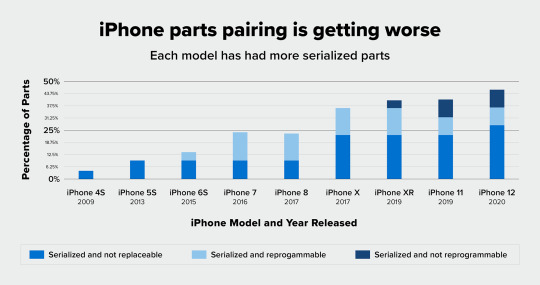
Every generation of Apple devices does more parts-pairing than the previous one, and the current models are so infested with paired parts as to be effectively unrepairable, except by Apple. It's so bad that iFixit has dropped its repairability score for the iPhone 14 from a 7 ("recommend") to a 4 (do not recommend):
https://www.ifixit.com/News/82493/we-are-retroactively-dropping-the-iphones-repairability-score-en
Parts-pairing is bullshit, and Apple are scum for using it, but they're hardly unique. Parts-pairing is at the core of the fuckery of inkjet printer companies, who use it to fence out third-party ink, so they can charge $9,600/gallon for ink that pennies to make:
https://www.eff.org/deeplinks/2020/11/ink-stained-wretches-battle-soul-digital-freedom-taking-place-inside-your-printer
Parts-pairing is also rampant in powered wheelchairs, a heavily monopolized sector whose predatory conduct is jaw-droppingly depraved:
https://uspirgedfund.org/reports/usp/stranded
But if turning phones into e-waste to eke out another billion-dollar stock buyback is indefensible, stranding people with disabilities for months at a time while they await repairs is so obviously wicked that the conscience recoils. That's why it was so great when Colorado passed the nation's first wheelchair right to repair bill last year:
https://www.eff.org/deeplinks/2022/06/when-drm-comes-your-wheelchair
California actually just passed two right to repair bills; the other one was SB-271, which mirrors Colorado's HB22-1031:
https://leginfo.legislature.ca.gov/faces/billNavClient.xhtml?bill_id=202320240SB271
This is big! It's momentum! It's a start!
But it can't be the end. When Bill Clinton signed DMCA 1201 into law 25 years ago, he loaded a gun and put it on the nation's mantlepiece and now it's Act III and we're all getting sprayed with bullets. Everything from ovens to insulin pumps, thermostats to lightbulbs, has used DMCA 1201 to limit repair, modification and improvement.
Congress needs to rid us of this scourge, to let us bring back all the benefits of interoperability. I explain how this all came to be – and what we should do about it – in my new Verso Books title, The Internet Con: How to Seize the Means of Computation.
https://www.versobooks.com/products/3035-the-internet-con


If you'd like an essay-formatted version of this post to read or share, here's a link to it on pluralistic.net, my surveillance-free, ad-free, tracker-free blog:
https://pluralistic.net/2023/09/22/vin-locking/#thought-differently

Image: Mitch Barrie (modified) https://commons.wikimedia.org/wiki/File:Daytona_Skeleton_AR-15_completed_rifle_%2817551907724%29.jpg
CC BY-SA 2.0 https://creativecommons.org/licenses/by-sa/2.0/deed.en
--
kambanji (modified) https://www.flickr.com/photos/kambanji/4135216486/
CC BY 2.0 https://creativecommons.org/licenses/by/2.0/
--
Rawpixel (modified) https://www.rawpixel.com/image/12438797/png-white-background
#pluralistic#vin locking#apple#right to repair#california#ifixit#iphones#sb244#parts pairing#serialization#dmca 1201#felony contempt of business model#ewaste#repairwashing#fuckery
1K notes
·
View notes
Text
Boost Your PC Performance with Blumenit Computer: The Best in Tech Solutions
Looking to enhance your PC’s performance or upgrade to the latest tech? At Blumenit Computer, we offer top-quality hardware and expert solutions for all your computing needs. Whether you need powerful processors like the Intel Core i7 for gaming, content creation, or general use, or you're in search of high-performance GPUs, we’ve got you covered.
From laptops to desktop components, our extensive range of products ensures that you find exactly what you're looking for. Need advice on the best options for your system? Our knowledgeable team is here to guide you through the process, ensuring you make informed decisions.
Visit Blumenit Computer today and elevate your tech experience with the best in the business!
#blumenit#rtx4060#hplaptops#laptop#intel#amd#hp#PC performance#tech solutions#Intel Core i7#Blumenit Computer#gaming PC#computer upgrades#desktop components#high-performance hardware#laptop solutions#computer advice#PC optimization#technology#PC building#powerful processors#best laptops#computer products#tech support#IT solutions#Blumenit#advanced computing#hardware upgrades#custom PCs
0 notes
Text
building keyboards! l.hs



pairing! lee heeseung x fem!reader
synopsis! in which you want to celebrate your one year anniversary with your boyfriend
genre! established relationship, fluff
word count! 1.2k
author’s note! i have been cursed by a keyboard obsession since before i even got into enhypen, so ofc i had to write something short and cute with heeseung
currently playing . . . highway 1009 by enhypen !

You met Heeseung entirely by chance. The two of you moved in completely different social circles, yet you somehow managed to find each other when it mattered the most. He was the popular guy on campus, whereas you were just a girl. A student trying to survive university life, juggling studying and a part-time job to keep yourself afloat.
The first time you met Heeseung was in the summer. After you managed to get through freshman year without failing a single class, you enjoyed your time off in a tech store, looking over different kinds of mechanical keyboards and computer components. You must’ve looked like an employee because Heeseung chose to approach you specifically to ask you a question about the new Keychron keyboards. And whilst you were not working at the store, you did know enough about the best, pretty affordable keyboards on the market. Including the new Keychrons. So you indulged him rather than telling him that you were not, in fact, working there.
Unbeknownst to you (he shared that later into your relationship), Heeseung continued going to the tech store during the summer in hopes of encountering you again, which was how he came to the conclusions that 1) you were truly not working there, and 2) he should’ve asked for your number.
It was only his luck that in the following winter semester, he happened to be a TA of one of the computer language classes you signed up for in your second year. He did not miss his chance to get to know you then, and the first time he asked you out was after the winter semester, when he was no longer the TA in your class.
It’s been a year since the two of you officially became boyfriend and girlfriend, and you got the most brilliant idea for how to celebrate your one year anniversary. It cost quite a good deal of money, but you knew it would be worth it in the end.
When you knocked on the door of Heeseung’s dorm room with two large plastic bags in hand, you knew he wasn’t home. However, at least one of his dorm mates should be, which was proven to you when Jay opened the door.
He looked at you with furrowed brows, and before he could tell you that Heeseung wasn’t there, you stopped him with: “I know, he’s not here. That’s the point.”
You didn’t even wait for the man to invite you inside. Rather, you made your way past him, taking your shoes off and heading toward the living room area to place everything on the dining table they had.
“What exactly are you doing, Y/N?” Jay asked, standing in the hallway like a father of three children with his hands on his hips.
“Preparing a surprise for Hee,” you replied simply, unpacking your boxes with mechanical switches, keycaps, keyboard cases, brushes, lube (for the switches), foam, tape, switch and keycap pullers and many other items necessary for building and modding your own keyboard. Since Keychrons were Heeseung’s favourite, you mainly went for components of that brand, but you were personally a fan of Akko keyboards, so you sneaked in a few switches from them for more options, too.
“Are you planning to build keyboards with him?”
You hummed with a nod of agreement, grinning.
“What do you think?” You turn to Jay once you have everything set up on the table.
“That Heeseung’s a lucky bastard,” Jay murmured under his breath, and you giggled.
“So it’s good, right?”
“Duh.” Jay shook his head, staring at everything you prepared. “Are you trying to one-up him? ‘Cause I don’t think he can come up with anything better than this.”
You shrugged, smiling. “I don’t really care. Seeing him smile is all I need.”
Jay rubbed his face. “Lucky bastard,” he repeated again. “I’ll make sure he knows that.”
“You’re too sweet,” you said, checking the time. Heeseung should be home from his class in about fifteen minutes. You knew only because he had texted you the approximate time when he would get home after you told him you had a surprise for him.
“So sweet that I’m gonna get lost and leave you two here alone.” He nodded, going to his room to grab some things. “Just text me whenever you guys are done, so I know I can come home.”
“Sure, sure, will do,” you mutter while eyeing your work. Not that spreading miscellaneous keyboard components was hard work, but you were already fighting the urge to start building a keyboard without Heeseung here.
After Jay left, you were alone in the dorm room for about three seconds. Heeseung burst into the dorm room with his backpack hanging over one shoulder, eyes already searching for you since he probably ran into Jay on his way here.
You smiled, watching him drop everything on the floor just to approach you.
“Surprise!” you exclaimed, pointing at the messy table.
Heeseung blinked at you, glancing between the keyboards and you in confusion. “What—”
“I have everything! And for modding, I have lube and foam and tape! Isn’t it awesome?” you asked, picking up each item you named.
Heeseung laughed at how innocently you said that despite its many possible meanings. Running a hand through his hair, he felt a swelling in his heart at the sight of your excited form over building keyboards. It was an interest you both shared, and he was eternally grateful for finding you over it every day.
“You know—” he grinned, picking up the lube— “when you said you had a surprise for me, I didn’t think the only thing I’d be lubing today would be keyboard switches.”
You giggled, shrugging. “But you like it anyway, right?”
“I love it,” Heeseung said, grinning. “I love you,” he added, sitting down next to you at the table. “That’s what matters the most, right?”
Leaning toward you, he cupped your chin and connected your foreheads. You couldn’t stop smiling as your heart drummed in your ears, your whole body seeping with love for the man in front of you.
“I love you, too,” you replied, connecting your lips in a brief kiss. “But can we start with building our keyboards? I want to make mine sound creamy… or should I go for thocky? I can’t decide.”
Heeseung chuckled, shaking his head. “I hope you know I don’t have much space in my room anymore.”
“That’s a lie and we both know it.” You looked at him, narrowing your eyes. “Unless being able to play Twister in your room is a requirement.”
Heeseung rolled his eyes. “For the two of us? Might as well be.” He wiggled his eyebrows at you, and you lightly slapped his shoulders, your cheeks heating up.
“Shut up,” you mumbled.
Heeseung giggled, capturing your lips in another, longer and much sweeter kiss.
“Thank you for all of this, though,” he said after, pointing at the setup. “My surprise suddenly seems lame.”
“What is it?” You pouted, curiosity taking over you.
“I’d rather not say right now.” Heeseung shook his head. “Maybe you’ll find out later.”
“That’s so mean.”

tag list! @moonpri (send an ask to be added to the permanent tag list!!)
#enhypen#enhypen fic#enhypen ff#enhypen x reader#lee heeseung x reader#heeseung x reader#heeseung fic#heeseung fluff#heeseung drabble#haia writes
124 notes
·
View notes
Text
Legislation under the moniker “right to repair” has now been introduced in all 50 states, marking a major milestone in this grassroots consumer movement.
GNN has reported on the march of right to repair laws across the US, but also the kind of entrepreneurialism they engender: like an aftermarket auto parts company that makes replacements for well-known faulty components in automobiles.
Passed in New York, Minnesota, Colorado, California, and Oregon, Wisconsin just became the final US state to introduce some sort of right to repair laws.
In broad terms, all of these bills would generally guarantee a consumer’s right to access replacement parts for devices and machines, repair manuals or other relevant documents for expensive products, diagnostics data from original manufacturers, and even in some cases, such as automobiles, appropriate tools necessary for maintenance.
They may also ban the use of technological protection measures, sometimes called “software locks” that are designed to restrict repair only to authorized repair technicians.
“Americans are fed up with all the ways in which manufacturers of everything from toasters to tractors frustrate or block repairs, and lawmakers are hearing that frustration and taking action,” Nathan Proctor, right to repair director for consumer rights group PIRG, told 404 Media’s Jason Koebler, who has been tracking right to repair legislation for 10 years.
OF A SIMILAR SPIRIT: 580 Repair Shops Form a Flourishing Subculture Fixing Toasters, Electronics, Coffee Makers and Lamps
He details that at first, big tech and big engineering, such as Apple, John Deere, and others, ardently lobbied against these bills, saying that trade secrets protections would be violated if they were forced to turn over diagnostics, telemetry, or other insider data to non-company actors.
The progressive difficulty with which modern products, particularly electronics, are designed prevents most amateurs from being able to repair them if they break.
MORE RIGHT TO REPAIR NEWS: EU Approves Groundbreaking New ‘Right to Repair’ Laws Requiring Appliances to Be Easier to Fix
Screws are forsaken in favor of plastic locking toggles which break if removed, fuse or wire cover panels are replaced with jointless polymer molded covers, both of which and many more examples besides are designed to deter the fix-it-minded folks enough so that they will just throw the product away and buy a new one.
Electronic waste is one of the largest sources of non-recyclable landfill waste, and hopefully enough of these right to repair bills pass that some of these millions of powerstrips, lamps, phones, computers, and televisions can be kept out of the ground.
76 notes
·
View notes
Text


we're so back. on the newest (supported, available on debian 12 stable) kernel and the wifi works great. anyone running a new lenovo or hp system can fix their wifi with this one easy step (note: actually a long list of steps)
installing linux on new computers is all fun and games until the kernel included with your distro version doesn't support your wifi chipset
#i've never manually updated the kernels because i've never had a reason to tbh#like the desktop computer upstairs has components from 2014-2015#those are supported by everything out of the box ngl#i've never run anything so new so i'm learning as i go!#minecraft time :3#text#rambles#tech
3 notes
·
View notes